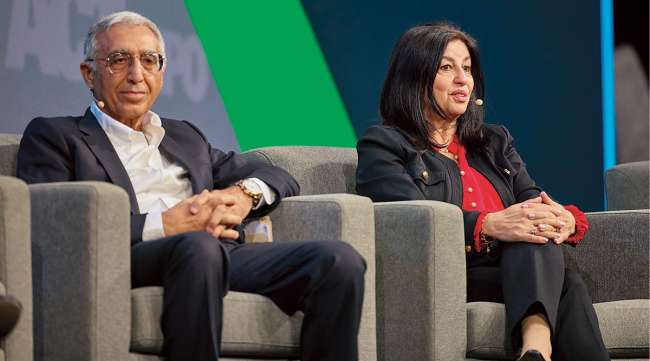The adoption of low- and zero-emission commercial trucks relies on the development of new fueling and charging infrastructure, but industry leaders must overcome numerous challenges.
Energy sector leaders emphasized the need for government incentives, consistent energy policies, and industry partnerships to facilitate the shift to cleaner trucks and supporting infrastructure.
“We are trying to skate where the puck is,” said Andy Walz, president of Americas products at Chevron. “It is a big challenge today to get people to pay more for products.” Walz was among the speakers at the 2024 Advanced Clean Transportation Expo, held May 20-23, discussing the needs for commercial vehicle fueling and charging infrastructure.
Selda Gunsel, chief technology officer and executive vice president technology for Shell Group, highlighted the dual challenge of increasing energy production while reducing emissions. “We know there is not one solution that can enable energy transition, so we have to work on multiple solutions,” she said.
Alongside the rollout of battery-electric trucks, industry stakeholders are exploring alternatives like biofuels, renewable diesel, renewable natural gas, hydrogen fuel cell trucks, and hydrogen combustion engines.
Chevron’s Walz expressed concerns over regulatory requirements in some areas, like California, favoring a single strategy of electrification. “Make sure you’re not limiting options. Put all options on the table,” he said, adding that energy needs to be affordable, reliable, and cleaner.
Chanel Parson, director of clean energy and demand response for Southern California Edison, stated that unprecedented electrification is needed for California to reach carbon neutrality by 2045. The electrical grid must be updated rapidly to meet EV charging demands, but grid projects can take years to complete.
If we don’t start now, we will be too late to meet the demand that arises.
Chanel Parson, director of clean energy and demand response for Southern California Edison
SCE is advocating for expedited permitting for grid construction projects and upgrading the grid in key areas like ports and freight corridors.
Gunsel raised similar concerns about the buildout of EV charging infrastructure, noting that it can take 12 to 24 months for utilities to meet energy needs, creating barriers to EV adoption.
Microgrids, local electrical grids built on-site, are one tool to meet demand. WattEV has created a microgrid at its Bakersfield, Calif., location, costing over $25 million. “It is possible to reduce the cost of energy,” said Emil Youssefzadeh, chief technology officer and co-founder of WattEV.
Salim Youssefzadeh, CEO of WattEV, outlines the company’s expansion plans during a news conference at ACT Expo 2024. (ACT Expo)
TravelCenters of America is installing a microgrid at its busiest location in Ontario, Calif., to help meet power needs without facing higher surge pricing.
John DeBoer, head of eMobility solutions in North America for Siemens, noted the complex pricing models for electricity across the U.S. grid, affecting the economics of charging sites. “Price spreads are growing dramatically,” he added.
Incentives from the Inflation Reduction Act of 2022 and Infrastructure Investment and Jobs Act of 2021 can help fund microgrids. Tax incentives and grants are crucial in attracting capital to low-carbon options.
“It will take a tremendous amount of money and subsidies to make a real difference,” said Chevron’s Walz. SCE is transitioning from incentivizing light-duty vehicles to medium- and heavy-duty vehicles, according to Parson.
Many low- and zero-emission solutions cost more than diesel equivalents, with few customers willing to pay more today. “That is a watch point,” Walz said, though the economics are expected to change as adoption increases.
“Once we get enough infrastructure and up-front capital, the vehicles and transformation will pay for themselves,” said SCE’s Parson.
Partnerships among utilities, policymakers, regulators, private companies, and equipment manufacturers are key to rolling out new fueling infrastructure. Shell has partnered with BYD in China and Cummins on natural gas engines, and is a founding partner of the H2Accelerate foundation in Europe to enable hydrogen fueling.
While hydrogen and electrification are long-term solutions, biofuels, renewable diesel, and renewable natural gas can reduce emissions today. “We have made a lot of investments in second-generation biofuels that do not compete with food sources,” said Gunsel.
Chevron acquired Renewable Energy Group in 2022 for $3.15 billion and plans to grow its biodiesel production. “We’re also believers in renewable natural gas and compressed natural gas,” Walz added.
Walz also mentioned that current government policies are not favorable for biodiesel and renewable diesel. Strong and consistent energy policies are essential for the energy transition.
“Policy is the single biggest risk factor,” Walz said, emphasizing the need for resilient policies beyond short political cycles. Despite challenges, motivated parties are pushing ahead to meet fleet needs.
Original Story at www.ttnews.com
